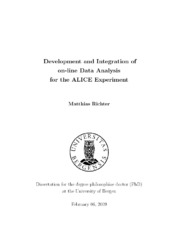| dc.description.abstract | The ALICE detector setup is a dedicated experiment in Heavy Ion Physics, located at the Large Hadron Collider (LHC) at the European Organization for Nuclear Research (CERN)/ Geneva. Its various sub-detectors are electronically read out by a few millions of channels and are expected to provide a huge sample of data for the investigation of strongly interacting matter. A data rate of up to 25 GByte/s imposes a challenge to both storage facilities and subsequent data analysis. On-line data processing is applied in order to reduce the data volume and selection of interesting events is suggested to increase the valuable information in the recorded data. In general, trigger systems cover the task of event selection. As the first signal needs to be available immediately after the collision, often a multi-level triggering scheme is applied. Fast detectors are deployed to generate different levels of hardware triggers. Subsequent software triggers accomplish event selection on the basis of on-line analysis. A High-Level Trigger (HLT) system has been implemented in ALICE which provides sufficient computing resources and infrastructure. It allows on-line event reconstruction at the full data rate and generates trigger information based on reconstructed events. HLT combines efficiently the communities of computing and physics. It thus requires a modular design for optimized workflows and well defined interfaces for exact communication as an integral part of the project. The ability of selection and rejection of events has direct impact on the data analysis performance and physics results. On-line algorithms have therefore to be evaluated and compared to the results of the general analysis. This thesis has contributed to the overall design of on-line data processing with ALICE HLT. Data flows have been developed and implemented, and a modular concept based on a common HLT analysis framework and abstract interfaces has been established. HLT on-line analysis has been integrated into the ALICE computing model. The work describes in particular the important aspects which have been considered during the design of modularity, the HLT analysis framework and related software, as well as the application of all new developments for one specific sub-detector. | en_US |
